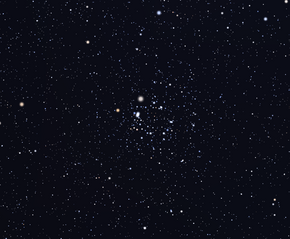NGC 2439
| NGC 2439 | |
|---|---|
 NGC 2439 (taken from Stellarium) | |
| Observation data (J2000 epoch) | |
| Right ascension | 07h 40m 45.0s[1] |
| Declination | −31° 41′ 36″[1] |
| Distance | 3.855 kpc (12.57 kly)[2] |
| Apparent magnitude (V) | 6.9[3] |
| Apparent dimensions (V) | 10″[4] |
| Physical characteristics | |
| Radius | 82 ± 23 ly (tidal) |
| Other designations | Cr 158, C 0738-315[3] |
| Associations | |
| Constellation | Puppis |
NGC 2439 is a sparse[5] open cluster of stars in the constellation Puppis. It has an apparent visual magnitude of 6.9, an angular size of 10 arcminutes, and is visible using a small telescope.[4] This is a young cluster with age estimates in the range of 20–300 million years.[6][7] It has a tidal radius of approximately 82 light years.[2] No chemically peculiar stars have been found.[6]
Distance estimates to this cluster vary widely.[5] Piskunov and associates (2008) gave an estimate of 3,855 kpc.[2] A value in the range 3–4 kpc means the cluster lies well below the Galactic Plane. It is positioned in a hole in the Milky Way's gas and dust, with the reduced absorption resulting in a lower than expected extinction of 1.27 in visual magnitude. This result raises the question of whether this cluster actually exists.[5] It is positioned along the same line of sight as two groups of B-type supergiant stars. The nearer group is located at a distance of 1.03 kpc, while the second group is at 3.2 kpc.[8]
Gallery
[edit]-
Map showing the location of NGC 2439
References
[edit]- ^ a b Wu, Zhen-Yu; et al. (November 2009). "The orbits of open clusters in the Galaxy". Monthly Notices of the Royal Astronomical Society. 399 (4): 2146–2164. arXiv:0909.3737. Bibcode:2009MNRAS.399.2146W. doi:10.1111/j.1365-2966.2009.15416.x. S2CID 6066790.
- ^ a b c Piskunov, A. E.; Schilbach, E.; Kharchenko, N. V.; Röser, S.; et al. (January 2008). "Tidal radii and masses of open clusters". Astronomy and Astrophysics. 477 (1): 165–172. Bibcode:2008A&A...477..165P. doi:10.1051/0004-6361:20078525. See online data.
- ^ a b "NGC 2439". SIMBAD. Centre de données astronomiques de Strasbourg. Retrieved 2020-09-01.
- ^ a b Bakich, Michael E. (2010). 1001 Celestial Wonders to See Before You Die: The Best Sky Objects for Star Gazers. Patrick Moore's Practical Astronomy Series. Springer. p. 29. ISBN 978-1-4419-1776-8.
- ^ a b c Kaltcheva, N.; et al. (June 2001). "The association surrounding NGC 2439". Astronomy and Astrophysics. 372: 95–104. Bibcode:2001A&A...372...95K. doi:10.1051/0004-6361:20010380.
- ^ a b Paunzen, E.; Maitzen, H. M. (April 2002). "CCD photometric search for peculiar stars in open clusters. III. NGC 2439, NGC 3960, NGC 6134, NGC 6192 and NGC 6451". Astronomy and Astrophysics. 385 (3): 867–873. Bibcode:2002A&A...385..867P. doi:10.1051/0004-6361:20020184.
- ^ Dias W.S.; Alessi B.S.; Moitinho A.; Lepine J.R.D. (July 2002). "New catalog of optically visible open clusters and candidates". Astronomy and Astrophysics. 389 (3): 871–873. arXiv:astro-ph/0203351. Bibcode:2002A&A...389..871D. doi:10.1051/0004-6361:20020668. S2CID 18502004. Note: see the VizieR catalogue B/ocl.
- ^ Kaltcheva, N. T.; Hilditch, R. W. (March 2000). "The distribution of bright OB stars in the Canis Major-Puppis-Vela region of the Milky Way". Monthly Notices of the Royal Astronomical Society. 312 (4): 753–768. Bibcode:2000MNRAS.312..753K. doi:10.1046/j.1365-8711.2000.03170.x.
External links
[edit] Media related to NGC 2439 at Wikimedia Commons
Media related to NGC 2439 at Wikimedia Commons

